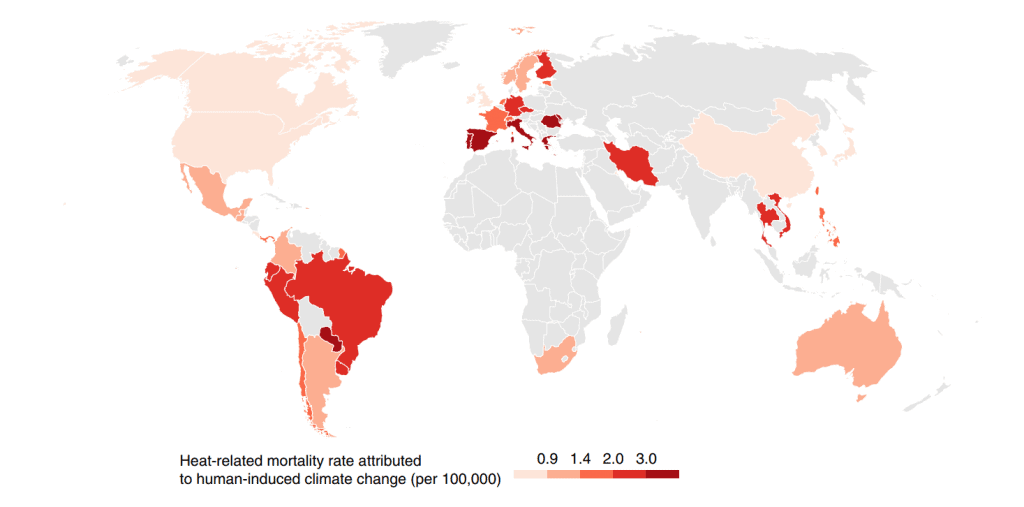Climate change has direct and visible impacts on the world, such as intense drought, more frequent and intense storms, rising sea levels, melting glaciers, and warming oceans. These all can directly harm animals, destroy their habitats, and wreak havoc on people’s livelihoods and communities. But one of the clearest fingerprints of climate change is the exacerbation of heatwaves, both in frequency and intensity, which is a huge concern. A new study suggests that up to 37% of global heat-related human deaths can be attributed to anthropogenic climate change.
Southern Europe, and southern and western Asia are among the most affected regions

The world is now 1 °C warmer, on average, compared to the pre-industrial era, although some regions have warmed more than others. For instance, since 2000, Arctic temperatures have risen about twice as fast as global temperatures. As a result, heat waves have become even more extreme and dangerous.
While most studies that have attempted to assess the impact of climate change on people’s health and risk of death did so over a continuum of temperature-related events, researchers led by Ana Vicedo-Cabrera of the University of Bern, Switzerland, undertook the tremendous task of quantifying the health burden of extreme temperature swings.
The researchers employed data on daily mortality observations from 732 locations across 43 countries to investigate the impact man-made climate change has had on human mortality due to heat over the past three decades (1991–2018). Although this data was robust, the study did not include data from several key regions — such as some parts of Africa and South Asia. The most reliable datasets covered North America, South America, and Europe. So this isn’t a truly global analysis but it’s the best we have given the circumstances — and the results are concerning.
In Paraguay and North Vietnam, the researchers found that mortality from all causes increased by up to 5% since pre-industrial times solely due to more heat-related deaths. In countries in eastern Asia or northern Europe, the total mortality increased by 1% due to more heat-related events. Across all locations, heat-related mortality amounted to an average of 1.56% of all deaths occurring during the warm season.
Virtually every inhabited continent has experienced a rise in mortality due to heat-related events due to climate change since the pre-industrial era. However, not all countries, nor even cities within the same country for that matter, are affected equally. Besides heat itself, a certain demographic may see their risk of death increase due to a number of socio-economic factors. Those who can’t afford access to air conditioning or live in cities with poor health coverage are more vulnerable, for instance.
“Taken together, our findings demonstrate that a substantial proportion of total and heat-related deaths during our study period can be attributed to human-induced climate change, which is in
line with the small number of existing attribution studies on this topic, mainly from Europe,” the authors wrote in a paper published today in Nature Climate Change.
Previously, a 2020 study found that not only have we seen more and longer heatwaves worldwide over the past 70 years, but this trend has markedly accelerated. The Mediterranean region, for example, saw an overall increase in heatwave duration of two days per decade. When looking at the 1980-2017 time frame specifically, the team found an increase in heatwave days of 6.4 days per decade. This suggests that most if not all of the increase has been focused in these last decades. And another disturbing report found that worsening heatwaves could kill more than 8 million people by 2100.
The real toll of heat-related events due to climate change is likely severely underestimated given that the countries and regions where the data was missing are also among the poorest and most susceptible to climate change.
“This has occurred with average global temperature increase of only ~1 °C, which is lower than even the strictest climate targets outlined in the Paris Agreement (1.5–2 °C) and a fraction of what may occur if emissions are left unchecked26. As a result, our findings provide further evidence of the potential benefits of adopting strong mitigation policies to reduce future warming and of enacting adaptation interventions to protect populations from the adverse consequences of heat exposure,” the researchers concluded.






